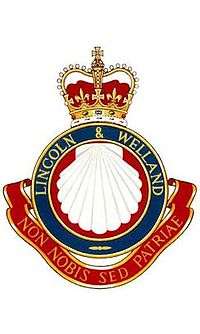The Lincoln and Welland Regiment
| The Lincoln and Welland Regiment | |
|---|---|
|
The badge of the Lincoln and Welland Regiment | |
| Active | 1863–present |
| Country |
|
| Branch | Canadian Army |
| Type | Infantry |
| Role | To close with and destroy the enemy |
| Size | One battalion |
| Part of |
32 Canadian Brigade Group 4th Canadian Division |
| Garrison/HQ | based in St. Catharines and Welland, Ontario. |
| Motto(s) | Non Nobis Sed Patriæ, "Not for ourselves but for our country". |
| March | The Lincolnshire Poacher |
| Decorations | . |
| Commanders | |
| Colonel-in-Chief | The Countess of Wessex |
The Lincoln and Welland Regiment is a Primary Reserve infantry regiment of the Canadian Army based in St. Catharines and Welland, Ontario.
The regimental colonel-in-chief is The Countess of Wessex and the regimental motto is Non Nobis Sed Patriæ, "Not for ourselves but for our country".
Cap badge
The crown represents service to the Sovereign. The design commemorates the former units which were amalgamated in 1936 to form the regiment. The general outline of the badge is derived from the badge of The Lincoln Regiment and the escallop, an emblem used by the former County of Welland, is from the badge of The Lincoln and Welland Regiment. "LINCOLN and WELLAND" is a form of the regimental title and "NON NOBIS SED PATRIAE is the motto of the regiment meaning "Not for Ourselves but for Our Country". [1]
Lineage
The Lincoln and Welland Regiment originated in St. Catharines, Ontario on 18 March 1863 as The 19th Battalion Volunteer Militia (Infantry), Canada. It was redesignated as the 19th "Lincoln Battalion of Infantry" on 28 September 1866; as the 19th St. Catharines Battalion of Infantry on 1 October 1897; as the 19th St. Catharines Regiment on 8 May 1900; as the 19th "Lincoln" Regiment on 2 November 1912; and, following the Great War, as The Lincoln Regiment on 1 May 1920. On 15 December 1936, it was amalgamated with The Lincoln and Welland Regiment and redesignated The Lincoln and Welland Regiment. During the Second World War it was redesignated as the 2nd (Reserve) Battalion, The Lincoln and Welland Regiment on 7 November 1940, returning to its pre-war designation as The Lincoln and Welland Regiment on 15 February 1946. [1]
The Lincoln and Welland Regiment originated in Clifton, Ontario, on 16 November 1866 as the 44th "Welland" Battalion of Infantry. It was redesignated as the 44th Lincoln and Welland Battalion of Infantry on 1 October 1897; as the 44th Lincoln and Welland Regiment on 8 May 1900; and following the Great War as The Lincoln and Welland Regiment on 1 May 1920. On 15 December 1936, it was amalgamated with The Lincoln Regiment and retained its designation. [1]
Perpetuated units
The Lincoln and Welland Regiment perpetuates the Battalion of Incorporated Militia of Upper Canada, The Coloured Corps (Captain Runchey’s Company of Coloured Men), the 1st, 2nd, 3rd, 4th, and 5th Regiments of Lincoln Militia of the War of 1812. [1]
Great War Canadien Expeditionary Force battalions perpetuated by the Lincoln and Welland Regiment include the 81st Battalion, CEF, the 98th Battalion (Lincoln & Welland), CEF, and the 176th Battalion (Niagara Rangers), CEF]]].[1]
History
Perpetuated units – 1794–1863
In 1794, John Butler, who had commanded Butler’s Rangers during the American Revolution was appointed Commanding Officer of three battalions of Nassau Militia. Nassau (later Home District) was one of the Districts of Upper Canada, Niagara being only part of the district. By 1791 the battalions had a strength of 835 all ranks.
With the reorganization of the province into sixteen counties in 1792, Lincoln County (with 20 townships) came into existence. The militia was renamed and the Lincoln Militia, with three battalions came into being, some 849 strong. By 1794, Butler was a full Colonel with four battalions reporting 976 all ranks. Many of the officers, NCOs and men had served with Butler’s Rangers during the Revolution and had received land grants in Niagara for this service. There is, however, no lineal connection of the Lincoln and Welland Regiment to Butler’s Rangers. [1]
By 1808, there were five regiments of Lincoln Militia:
- The 1st Regiment of Lincoln Militia, commanded by Col. Ralfe Clench and Lieutenant-Colonel Robert Kerr, drawn from Niagara, Louth and Grantham townships.
- The 2nd Regiment of Lincoln Militia, commanded by Lieutenant-Colonel Peter Ball, drawn from Stamford, Thorold and Pelham.
- The 3rd Regiment of Lincoln Militia, commanded by Lieutenant-Colonel Henry Warren, from Crowland, Willoughby and Bertie.
- The 4th Regiment of Lincoln Militia, commanded by Lieutenant-Colonel Johnson Butler from Grimsby and Clinton.
- The 5th Regiment of Lincoln Militia, commanded by Colonel Peter Hare and Lieutenant-Colonel Andrew Brandt from Ancaster, Barton, Saltfleet, Glanford and Binbrook.
At the outbreak of the War of 1812, flank companies (limited to three officers and 38 men), of the five regiments took the field in all major engagements from Niagara to Detroit including the battles of Queenston Heights, Lundy's Lane, Stoney Creek and Fort Detroit. The flank companies took the field together with Militias raised by various former officers including Colonel Isaac Swayze and did most of the militia's fighting. In all cases they were a credit to their country.
During the rebellion of 1837, units of the Lincoln Militia were called out to quell rebel uprisings in the Niagara Peninsula and the 2nd Lincolns were warned for duty in Toronto. In 1838, the 2nd conducted marches into the Short Hills to subdue rebel activity there. In 1846, Lincoln County was divided and Welland County was formed with three battalions of militia. The militia "regiments" were renamed "battalions".
Operational history
Fenian Raids
The 19th Battalion Volunteer Militia (Infantry), Canada was called out on active service on 1 June 1866 and served on the Niagara frontier. The battalion was removed from active service on 22 June 1866. [1]
The 19th "Lincoln" Battalion of Infantry was called out on active service on 24 May 1870 and served on the Niagara frontier. The battalion was removed from active service on 3 June 1870. [1]
Great War

The 19th "Lincoln" Regiment and 44th Lincoln and Welland Regiment were placed on active service on 6 August 1914 for local protection duties with the Welland Canal Force. [1]
The 81st Battalion, CEF was authorized on 10 July 1915 and embarked for Britain on 28 April 1916 where it provided reinforcements to the Canadian Corps in the field until 6 July 1916, when its personnel were absorbed by the 35th Reserve Battalion, CEF. The battalion was subsequently disbanded on 27 July 1917. [1]
The 98th Battalion (Lincoln & Welland), CEF was authorized on 22 December 1915 and embarked for Britain on 16 July 1916 where it provided reinforcements to the Canadian Corps in the field until 6 October 1916, when its personnel were absorbed by the 12th Reserve Battalion, CEF. The battalion was subsequently disbanded on 17 July 1917. [1]
The 176th Battalion (Niagara Rangers), CEF was authorized on 15 July 1916 and embarked for Britain on 29 April 1917. On 9 May 1917, its personnel were absorbed by the 12th Reserve Battalion, CEF to provide reinforcements to the Canadian Corps. The battalion was subsequently disbanded on 30 August 1920. [1]
Second World War
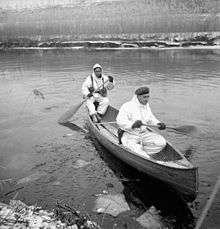
Between the wars, both the Lincoln Regiment and the Lincoln and Welland Regiment were greatly restricted in the training they were able to conduct. For example, the Lincoln Regiment trained 12 days in 1920, 9 days a year between 1922 and 1927, 12 days a year from 1928 to 1931 and 10 days a year from 1932 to 1936. On 15 December 1936, the two units were reorganized into The Lincoln and Welland Regiment with an establishment of 467 all ranks.
The regiment was called out on service on 26 August 1939 and then details were placed on active service on 1 September 1939, designated as The Lincoln and Welland Regiment, CASF (Details), for local protection duties. The details were formed as an active service battalion and designated The Lincoln and Welland Regiment, CASF on 15 August 1940. It was redesignated as the 1st Battalion, The Lincoln and Welland Regiment, CASF on 7 November 1940. The unit served in British Columbia, as part of the 13th Infantry Brigade, and in Newfoundland in a home defence role as part of Atlantic Command. On 16 July 1943 the 1st Battalion it embarked for Britain. On 25 July 1944 it landed in France as a part of the 10th Infantry Brigade, 4th Canadian Armoured Division, and it continued to fight in North-West Europe until the end of the war. The overseas battalion was disbanded on 15 February 1946.
The highest and most distinguished award for valour, the Order of the Bronze Lion was bestowed upon the regiment's Sergeant Wallace Edmond Firlotte.[2]
From Tilly-la-Campagne on 31 July 1944 until Bad Zwischenahn on 1 May 1945, the regiment distinguished itself in many actions. Over 1500 men of the regiment were casualties. Of the original men who enlisted in 1940, only three officers and 22 men were on parade in St. Catharines in 1946 when the 1st Battalion was dismissed.
Postwar
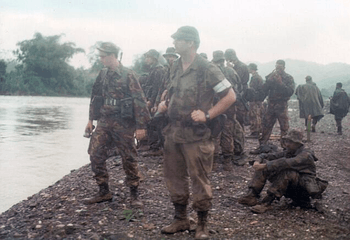
In the years since the Second World War, the regiment has busied itself with the many tasks traditionally entrusted to the Canadian Militia during peace time. Ceremonial parades have been attended and guards mounted, most notably the visits of The Princess Elizabeth (now Queen Elizabeth II) and Prince Philip to Niagara Falls in 1951 and Queen Elizabeth the Queen Mother to Niagara-on-the-Lake in 1981.
During the Blizzard of 1977 in the Niagara Peninsula the regiment was called out to provide assistance to the civil authority. It rescued over 1500 stranded school children and provided assistance to countless residents during the emergency. For this assistance, the regiment received a vote of thanks from the House of Commons. The regiment provided volunteers to assist during the 1997 Red River flood and the 1998 Ice Storm in Eastern Ontario and Quebec.
The year 1994 marked the 200th anniversary of the regiment and was commemorated in many ways. The trooping the colours, presentation of freedom of the town of Fort Erie and the dedication of the regiment's memorial garden all served to remind the regiment and the community of the service and sacrifice of two centuries.

Due to an administrative oversight, two battle honours earned in north-western Germany during the final weeks of the Second World War were not awarded to the regiment until 1995. In October 1995, at the regiment's annual church parade, scrolls commemorating the battles of Küsten Canal and Bad Zwischenahn were presented by members of the regimental association.
In 2012, as part of the Diamond Jubilee tour of Canada, Sophie Countess of Wessex presented new regimental colours to the regiment which included the battle honour NIAGARA based on the regiment's perpetuation of the Incorporated Militia Battalion of Upper Canada.[3] The regiment also perpetuates the 1st, 2nd, 3rd, 4th and 5th Regiments of the Lincoln Militia as well as the Coloured Corps from the War of 1812 thus linking the regiment to the Battles of Detroit, Queenston Heights and the Niagara campaign.
War in Afghanistan
The regiment contributed an aggregate of more than 20% of its authorized strength to the various task forces which served in Afghanistan between 2002 and 2014.[4]
Battle honours
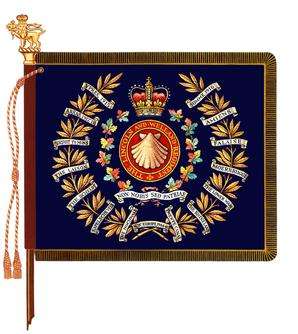
Battle honours in small capitals are for large operations and campaigns and those in lowercase are for more specific battles. Bold type indicates honours authorized to be emblazoned on regimental colours.[5]
- War of 1812
- First World War
-
- Ypres, 1915, '17
- Festubert, 1915
- Somme, 1916
- Arras, 1917, '18
- Hill 70
- Amiens
- Hindenburg Line
- Pursuit to Mons
- Second World War
- South-West Asia
Alliances

-
 United Kingdom – The Royal Anglian Regiment
United Kingdom – The Royal Anglian Regiment -
 United Kingdom – The Rifles
United Kingdom – The Rifles -
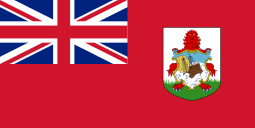 Bermuda – The Royal Bermuda Regiment
Bermuda – The Royal Bermuda Regiment -
 Australia – The Royal Queensland Regiment
Australia – The Royal Queensland Regiment -
 New Zealand – The Wellington (City of Wellington's Own) and Hawke's Bay Regiment
New Zealand – The Wellington (City of Wellington's Own) and Hawke's Bay Regiment
The regiment is also connected with cadet corps in St. Catharines and Fonthill, and with Robert Land Academy in Wellandport.
Media
- History of the Lincoln and Welland Regiment by Major R.L. Rogers (1989)
- The Lincs: A History of the Lincoln and Welland Regiment at War by Geoffrey William Hayes (1986)
- Presentation of New Colours to The Lincoln and Welland Regiment (M) by John Keiller (Lieutenant Governor of Ontario) Mackay (1959)
Music
Old Niagara waltzes by Maud Schooley was "dedicated to the 44th Lincoln and Welland Regiment, Canadian Infantry by special permission of Lt. Colonel Cohoe and officers of the Regiment". It was published in Toronto by Canadian-American Music, circa 1905[7]
19th St. Catharines Regiment march was not carried over as this regiment changed from 19th and 20th Battalions of Volunteer Militia (Infantry) Canada to: the 19th Lincoln Regiment (1912); Lincoln Regiment (192) and Lincoln and Welland Regiment (1936). Instead the Regimental march became The Lincolnshire Poacher.[8]
Lincoln and Welland Regimental Museum
|
| |
| Location | Butler's Barracks in Niagara-on-the-Lake, Ontario Canada |
|---|---|
| Website | |
The Lincoln and Welland Regimental Museum, located in Butler's Barracks in Niagara-on-the-Lake, features the history of the Lincoln and Welland Regiment. Exhibits include displays and artifacts from the 18th through the present, and include uniforms, weapons, medals, photographs, regimental band instruments, and other memorabilia. The displays show the regiment's participation in area military engagements in the 18th and 19th centuries, and overseas in World War I, World War II, for peacekeeping and other operations. The Museum is affiliated with: CMA, CHIN, OMMC and Virtual Museum of Canada.
Order of precedence
| Preceded by The Hastings and Prince Edward Regiment |
The Lincoln and Welland Regiment | Succeeded by 4th Battalion, The Royal Canadian Regiment |
See also
References
- 1 2 3 4 5 6 7 8 9 10 11 12 Canadian Forces Publication A-DH-267-003 Insignia and Lineages of the Canadian Forces. Volume 3: Combat Arms Regiments.
- ↑ he is buried in French River (Monetville), Ontario
- ↑ Welland Tribune http://www.wellandtribune.ca/2012/09/04/countess-of-wessex-to-visit-regiment-college
- ↑ http://pm.gc.ca/eng/news/2014/05/09/south-west-asia-theatre-honours
- ↑ "The Lincoln and Welland Regiment". Official Lineages Volume 3, Part 2: Infantry Regiments. Directorate of History and Heritage. Retrieved 27 January 2016.
- ↑ "South-West Asia Theatre Honours". Office of the Prime Minister of Canada. Retrieved 11 May 2014.
- ↑ "Old Niagara waltzes". Retrieved 9 January 2012.
- ↑ "Regimental Marches". Retrieved 14 February 2012.
| Wikimedia Commons has media related to The Lincoln and Welland Regiment. |
External links
- Official Website of The Lincoln and Welland Regiment
- Lincoln and Welland Regimental Museum
- Lieutenant Charles Pearson: The Lincoln and Welland Regiment's WWII Campaign
